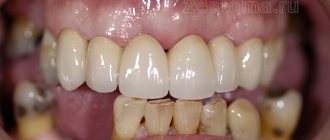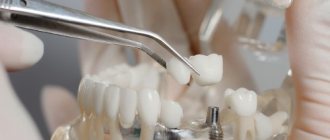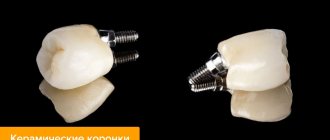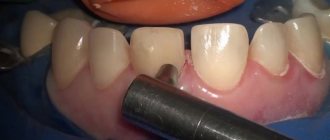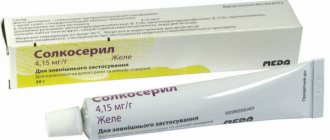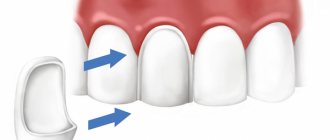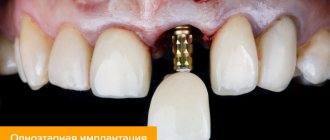The prosthetic procedure is the restoration of damaged or lost teeth, allowing not only to get a beautiful smile, but also to fully realize chewing functions. Various types of dental prosthetics used today make it possible to restore one tooth, several, and even the entire dentition.
First of all, from the point of view of patient convenience, dentures can be removable or non-removable. If it is necessary to replace one or more teeth, dentures are often permanent. In case of complete loss of dentition, previously only removable dentures were used, but today it is possible to install fixed dentures on implants.
What is fixed prosthetics?
Fixed prosthetics involves implanting an artificial root into the bone tissue where teeth are missing. Subsequently, a prosthesis is installed on the root. The patient will not be able to remove the structure on his own. There is another method of restoring the dentition - using removable structures. But it has disadvantages, so it is mainly used only if the patient is not suitable for fixed dentures.
Differences in dentures
How does the process of dental orthopedics work?
Regardless of the type of product, any dental element must be manufactured individually, taking into account anatomical features. Dentures are made in a laboratory.
- The patient must come for the first consultation, during which the doctor will help determine the choice of type of prosthetics, and may also prescribe additional tests.
- On the same day, an x-ray is taken to assess the condition of the oral cavity and bone tissue.
- Next, the preparatory process usually begins, which includes the necessary procedures to eliminate diseases of the teeth and gums.
- Then an impression of the teeth is taken, from which the technician makes a plaster mold, on the basis of which the entire structure is cast.
- Once the prosthesis is ready, it needs to be tried on, the dentist will look at how well the structure fits, and the patient will point out the shortcomings that need to be eliminated in the laboratory.
- The final stage will be the final installation of the orthopedic structure in its place. If this is a removable denture, then the dentist will help with installation the first time, but in the future the patient will no longer need additional help and will independently cope with its installation or removal.
When is fixed prosthetics prescribed?
Main indications for fixed dental prosthetics:
- the absence of one or more teeth – both nearby and in different parts of the dentition;
- congenital or acquired defects of tooth enamel (tetracycline teeth, fluorosis, discoloration due to injury or root canal treatment with outdated methods);
- large chips and cracks;
- the presence of spaces between teeth (diastema, trema);
- as a support for a bridge prosthesis.
Consequences of missing teeth
If you are missing 1 or more teeth, consider this dental restoration option. By delaying the process of prosthetics, patients waste time. In the future, the procedure will be more extensive, expensive, and painful.
Due to the increased load on the remaining teeth, they begin to decay faster. The bite is disturbed, pain appears in the temporomandibular joint.
What problems can be solved with dental orthopedics?
With the help of dental orthopedics, the following problems can be solved:
- Replace missing units with a prosthesis.
- Restore a severely damaged tooth
- Restore chewing function in complete absence of teeth.
- Prevent jaw tissue atrophy.
Dental orthopedics is designed to restore lost or damaged units. If only 1-3 teeth are missing, experts recommend installing non-removable dental products. If more than 3 teeth are missing, a clasp denture can be installed. Acrylic or nylon products are most often installed in the absence of a large number of teeth; they will cost much less, but in terms of comfort and aesthetic indicators they will be inferior to more expensive analogues.
Contraindications
Not all patients can get fixed dentures, because there are strong contraindications:
- pathologies of the temporomandibular joint;
- tooth mobility;
- chronic periodontal disease;
- pregnancy;
- severe bruxism;
- oncological diseases, blood diseases, mental disorders.
There are few absolute restrictions on installation. You can always choose the option of fixed prosthetics for each patient, taking into account his individual characteristics.
Zirconium dioxide and ceramics
Such dentures are flawless and are recommended for installation on the front teeth. The units are stronger than natural ones due to the stable zirconium frame, and the ceramic coating gives them a visual naturalness, ensuring correct light reflection.
But such a tooth crown is expensive. And it’s not always justified. Modern solid ceramics are close in strength to natural enamel. Therefore, in most cases, frameless ceramics, which are indistinguishable from natural units, are chosen for the restoration of the beauty area.
In addition, Cerec porcelain crowns for front teeth can be made within 1.5 hours; the price of this option is more affordable and its aesthetics are high. The artificial units created using innovative equipment will be flawless, you don’t need to get used to them - their parameters are calculated by a computer program taking into account the anatomical characteristics of a particular patient.
Types of fixed dentures
There are many different ways to restore teeth using fixed dentures, each of which has its own installation features, advantages and disadvantages.
Veneers
Veneers are distinguished by their features from all other types of dentures. These are just thin shells that are glued to the tooth surface. Indications for installation are dark enamel color that cannot be bleached, chips, cracks in the smile line, darkened filling. You can close a tooth gap with veneers.
Veneers on teeth
It is not advisable to carry out the procedure in the following cases:
- inflammation – caries, pulpitis, periodontal disease;
- interfering fillings;
- bruxism;
- malocclusion.
Ceramic (porcelain) onlays are fixed with dental cement. They last up to 10 years and are not painted. They are quite thick, you have to remove part of the enamel for normal fixation.
Lumineers, nanoveneers, glass veneers are ultra-thin and practically do not require removal of enamel. Installed instantly using special glue. They have an excellent aesthetic effect, do not damage teeth, and do not stain. You cannot chew with your front teeth or bite hard food.
Stump inlays
Stump inlays are used when the outer, chewing surface of the teeth is damaged. They are distinguished by reliable fastening and are not painted. They look natural and can last a long time. Inlays are preferable to fillings. The main indication is tooth decay of more than 30%. The inlays are made from durable materials and can last for a long time.
Installation of the stump tab
Dental bridges
This is a system that consists of several artificial teeth and crowns for attachment to healthy dental units. Fixed bridges are indicated when there is a deficiency of several units in one row. A structure is made that can withstand long-term loads. Strong fixation with dental cement is required. The solution prevents the structure from moving when chewing.
An adhesive dental bridge is gentle on teeth. No grinding of healthy teeth is required, but can only be used on one tooth. This is a one-piece crown with attachments to adjacent teeth on the lingual side. Dental glue is used for fixation.
A composite dental fixed prosthesis is used when the anchoring teeth cannot be properly processed due to their inclination in the mesial or distal position. For such situations, composite structures are provided that are secured using hooks (clasps), tabs, rings, various types of locks, and telescopic crowns.
Types of bridges
Indications:
- incorrect position of supporting elements;
- the presence of several support units;
- increase in supporting units with an existing prosthesis.
Cantilever is a non-removable denture, which is suitable in the absence of one unit, with a single fulcrum, instead of two, like a standard bridge. A cantilever is an artificial tooth in a denture. The supporting part on the adjacent healthy tooth in the form of a crown. Installed if for some reason it is impossible to install an implant. Placed in cases of loss of incisors and premolars.
Combined fixed denture . The main part is firmly fixed to the supports with a cementitious composition. Connected with locking fasteners. This could be a clasp design. It is attached using clasps and attachments.
Clasps are hooks that firmly hold the structure in the oral cavity. Disadvantage: noticeable, aesthetically unattractive. Attachments are means of fixation. Invisible in the oral cavity. The designs are distinguished by precision manufacturing, as 3D modeling is used. The physiological characteristics of the patient are taken into account. This makes them comfortable. There are no side effects. A person quickly gets used to the structure, chewing and speech functions are restored. The materials do not cause allergies. Serve for more than 10 years.
Crowns
Prosthetics using a crown is used to restore one tooth, even after complete destruction, but with the root preserved. Fixed crowns replicate the anatomical features of the teeth and completely restore chewing function. In dental practice, various types of dental crowns are used.
Types of crowns
Metal-plastic – conditionally temporary, which involves installation with a metal base in combination with a plastic coating. Metal structures are made of nickel, chromium or cobalt. The disadvantages include the rapid loss of appearance due to staining of the plastic when drinking coffee, strong tea and other coloring products. The crowns are not strong enough; an allergic reaction may develop to the metal.
Metal-ceramic - their base is made of cobalt, chromium, titanium, gold and other metals. For an aesthetic appearance, a ceramic layer is applied to it at high temperature. The advantages of metal-ceramic crowns include:
- High mechanical strength due to a cast metal frame. Ceramics are also durable.
- Aesthetics. They do not become colored when eaten with coloring foods (such as coffee). Chips of ceramics are rarely observed. Dentures are always tailored to the shape of the patient’s teeth and the color of the patient’s enamel; ceramics completely recreate the anatomical features of the enamel.
- Long service life. Metal-ceramic dentures last up to 20 years. With preventive measures I can last up to 35 years.
Metal - such crowns were previously used everywhere. Now they are most often installed only on chewing teeth due to aesthetics. They are made in the laboratory, stamped or cast with spraying. Metal crowns are very durable and reliable. They fit tightly to the tooth, preventing further destruction. Disadvantages include allergic reactions to metal. It must be taken into account that only one type of metal is used to prevent galvanic syndrome. This is a burning sensation in the mouth and a “metallic” taste. Gold crowns are made from an alloy of gold and palladium or platinum, since gold is a soft metal. They have excellent biocompatibility and do not cause allergies. But they do not look very good, so it is not recommended to place them on the front teeth.
Ceramic or metal-free crowns are the most aesthetic and beautiful crowns. They are practically indistinguishable from real teeth. All-ceramic or porcelain are made according to a personal impression from pressed material without other components. There are also mixed materials:
- ceramics with zirconium dioxide. It is a more durable material than pure ceramics. Due to the light transmittance, an almost complete imitation of real teeth is achieved. Zirconium crowns do not cause allergies.
- aluminum oxide and ceramics. This is a translucent hypoallergenic material that is comfortable and resistant to temperature fluctuations.
Positive aspects include low weight, good biological compatibility, and hypoallergenicity. They can be placed even on weakened teeth with minimal grinding. The main disadvantage is the high cost and fragility of ceramics. They are not designed for intense chewing loads; they are often installed on the upper incisors. Service life with proper care is up to 10–15 years.
Zirconium dioxide crowns are a modern material that is manufactured in a laboratory using computer equipment. Laser scanning is used to accurately analyze the dentition. A computer program simulates an accurate crown for the tooth. The data is transferred to a milling machine, which grinds the prosthesis from the workpiece. The main advantages include:
- high levels of mechanical strength.
- excellent aesthetic properties. Crowns are practically indistinguishable from the patient’s natural teeth.
- environmental friendliness and biological compatibility. Zirconium dioxide is safe for human health.
Acrylic and plastic crowns are a temporary option; they are used until permanent dentures are installed. They are placed to protect prepared teeth from destruction and to hide defects in the dentition on abutment teeth or implants. They provide a uniform load, reducing the risk of jaw bone resorption. A person gets used to a permanent prosthesis faster.
Fixed denture on implants
Implantation is the installation of an orthopedic structure that replaces teeth supported by artificial titanium implants, which are implanted into the patient’s jaw. Fixed dentures on implants allow:
- completely restore the full function of chewing, the aesthetic component;
- improve the quality of human life.
Advantages:
- aesthetics – the prosthesis cannot be distinguished from the patient’s own teeth;
- physiological – no discomfort when chewing. Does not feel like a foreign body;
- maintaining the integrity of your teeth;
- full chewing load allows you to preserve bone tissue;
- absence of the problem of an “senile” face - timely prosthetics will allow you to maintain a youthful appearance for a long time even in adulthood;
- simplicity, ease of maintenance - do not require additional equipment. It is enough to brush your mouth 2 times a day.
The following indications for implantation exist:
- single defect, especially in the smile area;
- absence of a significant number of teeth in a row;
- there is no last tooth where the structure can be secured;
- complete edentia is the only possibility that allows the structure to be securely fixed.
In the first days after installation of a fixed denture on implants, discomfort in the form of pain and swelling is possible. But as healing progresses, all discomfort goes away.
If previously prosthetics were performed only on implants that had taken root, modern materials and technologies make it possible to speed up the process. Exists:
- immediate installation (after implantation or in the first 3 days, this is called one-step implantation, such an operation is possible even immediately after tooth extraction);
- early exercise (from 2 to 6 weeks);
- late prosthetics (from 3 to 6 months).
In case of partial tooth defect, a one- or two-stage technique is performed with late installation of dentures on the implant. Fixation of crowns for 3 or 6 months after implantation. Engraftment of implants on the lower jaw takes 3 months, on the upper jaw from 5 to 6 months. Engraftment depends on bone density. When building bone tissue, the time period increases. Sometimes complete prosthetics are performed only after 1.5 years.
The indication for early loading is usually a missing front tooth, when the patient needs to eliminate an aesthetic problem. First, a temporary plastic crown is made. Then it is replaced with a permanent one made of zirconium.
Basal technique: with edentulous bone tissue often atrophies, the volume is not enough for implantation. Basal implants are used, which are installed in a deeper layer. This eliminates the need for bone grafting. The specialist must be fluent in the basal technique to avoid complications.
All-on-4, All-on-6: The technology was developed by implant manufacturer Nobel-Biocare from Switzerland. Its peculiarity is that the fixation of the entire fixed bridge prosthesis is carried out only on 4 or 6 implants.
Dentures on implants
In case of complete absence of front teeth, it is optimal to use 4 implants for prosthetics. The technique is safe for the patient and the installation takes place in a single visit, which allows you to get all your teeth back in one day. 6 implants are used in more complex cases (absence of all teeth, for example), as they allow the prosthesis to be secured in the mouth even more reliably. This type of prosthetics has been used for more than 20 years and has successfully proven itself among patients: dental units look great, chewing function is restored in full, and no special care is required.
With complete edentia, there are two scenarios for the development of events.
- The most common option is to make a completely removable structure from acrylic or nylon. It's fast and inexpensive, but sometimes it causes discomfort, which, however, can be fixed.
- But, if you have a budget, then it is better to install ceramic crowns supported by implants. This option will look much more aesthetically pleasing, and most importantly, it is more reliable and does not cause inconvenience.
If there is a badly damaged tooth, it can be restored by installing a ceramic filling or inlay, which will last much longer than a composite filling.
If dental orthopedics turns you off due to the need to sharpen adjacent units, there is a way out! In this case, give preference to the adhesive method of orthopedics. This technique is more gentle and eliminates the negative impact on supporting teeth.
Which fixed dentures to choose
Microprosthetics with veneers are recommended for restoration of the smile area. These are modern techniques that allow you to achieve aesthetics. In addition, they are not colored with food coloring.
In case of partial absence of teeth, implants or bridge types of prostheses are used. The best option is implantation of All on 4 or All on 6. They are characterized by a long service life and a good aesthetic effect. Bridge structures are suitable for installation directly on the upper and lower jaw.
Making crowns
Crowns are made from an impression that is taken from the prepared teeth. To obtain this impression, the orthodontist will use a special plastic mass. Based on the impression taken, the laboratory will first make a plaster model of the prosthesis, and then a crown, which will be placed on the tooth.
Modern dental crowns are made from different materials: metal, ceramic, metal-ceramic and zirconium. The timing of the production of the prosthesis will depend on what kind of crown it is decided to place on the tooth. Crowns made of ceramics and metal-ceramics take the longest to produce. So that a person does not have to walk without a tooth during the entire time of making the crowns, a temporary plastic prosthesis is put on the tooth.
IMPORTANT: Temporary plastic crowns help hide a defect in the dentition; a person will not have to be embarrassed by the absence of a tooth and experience stress for this reason. Also, temporary dentures help protect a ground and therefore weakened tooth from the negative effects of environmental factors and bacteria.
How does adaptation proceed after fixed prosthetics?
Adaptation to fixed species occurs individually. After installation, you may experience the following inconveniences:
- excessive salivation;
- gagging;
- discomfort during chewing;
- speech distortion;
- loss of taste.
The sensations last for several days. Many people complain of pain, scratches and abrasions. Pain when chewing at first may be normal. You need to limit solid foods. If you are salivating, you need to drink more, if you have a gag reflex, breathe through your nose, rinse your mouth with saline solution.
When to see a doctor
You should consult a doctor if there is severe pain, structural mobility, swelling in the area of the pins, or increased temperature. Timely assistance will help quickly resolve the problem. Independent actions lead to damage or breakage of the structure and rejection of the implant.
Metal and plastic
These are inexpensive crowns that have been placed on the front teeth for decades.
The metal base was covered with an inert synthetic. But time has shown the conventional aesthetics of the structures - over time, the coating darkened and the metal became visible. After a couple of years, a painful replacement of the prosthesis was required. Today, metal-plastic crowns are cheap and can be used for the restoration of molars. But their aesthetic life is maximum 3 years. Therefore, this option is recommended as temporary. Before permanent prosthetics during implantation or in other cases when it is impossible to install a permanent prosthesis immediately after treatment.
Care of fixed dentures
Doctors recommend following the rules of care after installation. This is necessary to speed up the survival rate and increase the service life of the structure.
Required:
- carry out dental hygiene at least 2 times a day;
- use a medium-hard brush;
- exclude viscous confectionery products, chewing gum, nuts, seeds, hot or too cold drinks;
- use the irrigator 2 times a day - morning and evening;
- brush your teeth with dental floss;
- eliminate smoking;
- Visit the dentist twice a year for hygienic cleaning.
Benefits of dental orthopedics
This direction in dentistry has several significant advantages:
- In a short period of time, aesthetic values can be restored.
- It has a reasonable price, especially when it comes to dental products that can be removed independently.
- Easy to carry out hygienic manipulations.
- You can choose different designs and select suitable fastenings.
- Any number of units can be restored, even with complete edentia.
- Dental orthopedics reduces the risk of developing bone tissue deficiency if the product involves a full load on the jaw.
- Minimum contraindications.
- Long service life. In most cases, artificial products will last more than 5 years.
- Chewing function is restored.
- The serious psychological consequences that arise from missing units can easily be avoided.
A dentist will help you decide on the type of product. The specialist will assess the condition of the oral cavity and advise (taking into account financial and physical characteristics) which design is right for you.
How much does fixed prosthetics cost?
The dental clinic in St. Petersburg “Yulistom” has a powerful diagnostic base and its own dental laboratory. Doctors were trained in the largest clinics in Europe and the USA. This allows for treatment and prosthetics in the most difficult cases. You can make an appointment on the website at a time convenient for the patient.
Approximate cost of prosthetics in our clinic:
| View | Price in rubles per unit |
| Veneers | from 18000 |
| Implants | |
| Hi-Tec | 27850 |
| Straumann | 44000 |
| Crowns | |
| Metal-ceramic | from 9500 to 15500 |
| Metal (cast) | 6500 |
| Temporary | 2000 |
| From zirconium dioxide | 25000 |
| Stump inlays | |
| Cast | 4000-5000 |
| From zirconium dioxide | 10500-13000 |
| Ceramic lined | 6000 |
Metal ceramics
If it is necessary to replace molars, ceramics will not be suitable; the material is too fragile and will not withstand the increased load. Therefore, it is more reasonable to install metal-ceramic or zirconium crowns on chewing teeth. The last segment is more expensive. Therefore, many patients choose a metal cast crown coated with ceramics.
Modern frames are made only by casting. This ensures a tight fit of the crown in the remains of the natural tooth, preventing the entry of pathogenic microflora into the tooth.
CAD/CAM system.
In the 21st century, digital technologies are conquering the world, including medicine. In dentistry, the most recent innovative discovery is the CAD/CAM technique. If we literally translate the foreign abbreviation into Russian, it will sound like: “computer-controlled production.” Kad/Kam technology is a new opportunity in dental prosthetics, thanks to which a crown can be made in one day.
The CAD/CAM complex includes:
- Scanner. It converts the information, creating a 3D model of the orthopedic system frame on a computer.
- Special computer. This is a kind of graphic editor, where the doctor uses the mouse to change and create elements of the simulated design. The virtual crown must completely match the jaw, in size and shape. Therefore, finished products are distinguished by high precision and quality.
- Milling machine. When the technician finishes designing the prosthesis, a computer file containing the restoration is sent to the machine. On it, a frame is cut from a blank, which was created in a 3D model. The following materials can be used: zirconium dioxide, plastic, titanium, cobalt-chromium alloy.
The CAD/CAM system is by far the fastest way to produce artificial teeth. The use of this technique allows us to obtain accurate and durable structures.
Modern prosthetic dentistry is a complex of services that includes: diagnostics, production of orthopedic systems and restoration of missing teeth. Today, patients have the opportunity to restore oral defects without harm to the body, with high quality and inexpensively. The A-medic clinic has all the necessary equipment and materials for removable or permanent prosthetics. Depending on the clinical case, our specialists will help you choose the appropriate design.



